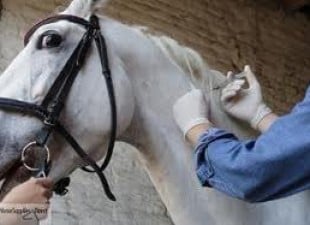On 3 May 2016, the Western Cape Department of Agriculture issued the following Situation Report on the Paarl African Horse Sickness outbreak.
Introduction
A case of African horse sickness (AHS) was detected through clinical surveillance by a private veterinarian in Paarl on 2 April 2016. Samples collected from the colt that became ill and died tested positive for AHS virus, subsequently shown to be serotype 1.
Cases
Three more horses on the same property as the index case, and four horses on four other properties in the Drakenstein Local Municipality have tested positive for AHS since 26 April 2016. Two of the latter cases have died. On all affected properties, the virus has been identified as serotype 1.
Control
Containment area and movement restrictions
As of 26 April 2016, the borders of the containment area were revised owing to a lack of indication of the outbreak being already widespread as there were no subsequent cases of AHS up to this date. Movement restrictions are still in force within this containment area surrounding the case. No movement of horses into, out of, through or within the containment area will be allowed without a movement permit from a state veterinarian.
The eastern border of the containment area follows the border of the AHS surveillance zone from the Jonkershoek area along the Limietberg mountain range to the Voëlvlei dam. The boundary then extends westwards past the southern end of the Voëlvlei dam to the R46, which it follows through Hermon, Riebeeck Kasteel and to Malmesbury. The western border of the containment area follows the R302 southwards until it intersects with the R304, which it follows into Stellenbosch and along Bird St until the intersection with Merriman Ave. The southern border follows Merriman Ave, Martinson Rd and Jonkershoek Rd to the east, through the Jonkershoek Valley and up the escarpment until it meets with the border of the AHS surveillance zone. The roads that make up the borders of the containment area are not included in the movement restrictions, and transport of horses along these roads is permitted.
An interactive map of the containment area can be obtained at www.elsenburg.com/vetepi under the Maps tab.
Permit applications should be made to authorised veterinarian Dr Camilla Weyer at [email protected].
Vaccination
Currently no vaccination against AHS is permitted within the containment area. Even when no outbreaks of AHS are occurring in the control zones, vaccination against AHS is strictly prohibited in the AHS surveillance and protection zones during the high vector risk period which is between 1 November and 31 May each year. A map of the AHS control zones can also be found at www.elsenburg.com/vetepi.
Owner actions
Horse owners are encouraged to stable their horses from two hours before sunset to two hours after dawn (to decrease the risk of the vector of the disease having contact with their horses) and to make use of a registered insect repellent on their horses during the vector feeding periods as indicated above. Further protection of the stabled horses can be attained by covering all stable openings with 80-100% shade cloth. Any owner within the AHS surveillance zone detecting illness in horses involving unexplained fever, swelling of the head and neck and difficulty breathing should report the case to their local State Veterinarian as quickly as possible. Contact details of regional state veterinary offices can be found on www.elsenburg.com.
Response
An initial census and surveillance programme by state officials in the area surrounding the affected property was performed to determine the extent of the outbreak. All properties on which horses are kept within 5km of the index farm were visited and approximately 200 horses sampled. All results were initially negative for AHS virus, and positive cases were only detected once a second round of surveillance within this area began. Surveillance activities within the containment area are continuing, with 54 properties having been visited for surveillance activities to date.
Private veterinarians in the affected area have also been requested to inform the State of any suspect AHS cases or cases indicative of infectious disease both within the containment area and within the AHS surveillance zone. All reports are followed up on and, where necessary, samples are taken to exclude AHS.
Source of infection
The source of infection is being investigated, but is yet to be established.










